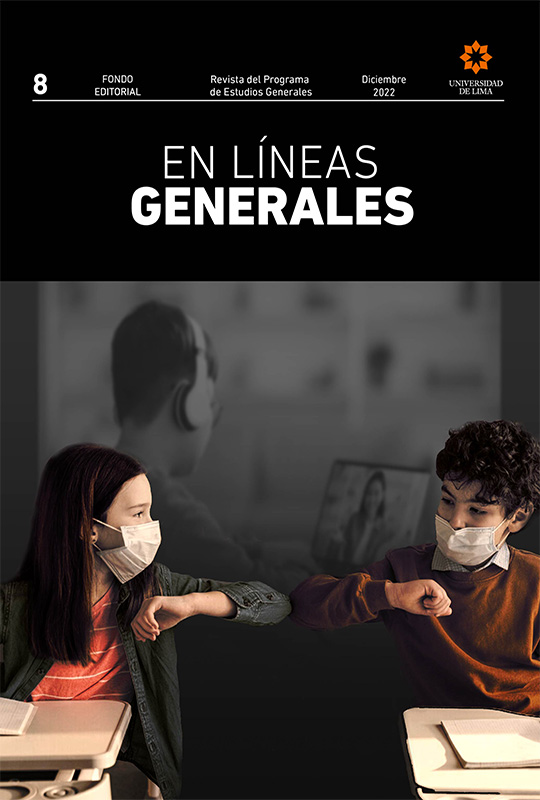El efecto de las áreas verdes urbanas en el desempeño académico en un contexto de pandemia
DOI:
https://doi.org/10.26439/en.lineas.generales2022.n008.5170Palabras clave:
salud mental, áreas verdes urbanas, desigualdad social, desempeño académicoResumen
Las áreas verdes urbanas son conocidas por transmitir paz y bienestar a las personas expuestas a ellas. Debido a ello, las políticas públicas consideran que las áreas verdes deben estar incluidas en la planeación urbana; sin embargo, la evidencia indica que no muchos centros urbanos tienen a su disposición dichas áreas; es decir, hay personas que, por vivir en ciertos distritos, se beneficiarían más de los efectos positivos de la naturaleza que otros. ¿Cómo se daría en el caso de los estudiantes durante la pandemia? Este ensayo presenta evidencia acerca de cómo la naturaleza nos mejora la calidad de vida y las repercusiones que nos produce al no estar expuestos a ella. Especialmente en estos tiempos de pandemia, porque en Lima no todos los distritos tienen el mismo acceso a dichas áreas.
Descargas
Referencias
Adams-Prassl, A., Boneva, T., Golin, M. & Rauh, C. (2020). The impact of the coronavirus lockdown on mental health: Evidence from the US. https://doi.org/10.17863/CAM.57997
Boals, A. & Banks, J. (2020). Stress and cognitive functioning during a pandemic: thoughts from stress researchers. Psychological Trauma: Theory, Research, Practice, and Policy, 12(1) (pp. 255-257). https://doi.org/10.1037/tra0000716
Bostani, M., Nadri, A. & Rezaee Nasab, A. (2014). A study of the relation between mental health and academic performance of students of the Islamic Azad University Ahvaz Branch. Procedia-Social and Behavioral Science 116 (pp. 163-165). https://doi.org/10.1016/j.sbspro.2014.01.186
Bowler, D., Buyung-Ali, L., Knight & Pullin, A. (2010). A systematic review of evidence for the added benefits to health of exposure to natural environments. BMC Public Health 10 (1) (p. 456). https://doi.org/10.1186/1471-2458-10-456.
Collado, S., Staats, H., Corraliza, J. A. & Hartig, T. (2017). Restorative environments and health. In G. Fleury-Bahi, E. Pol and O. Navarro (Eds.). Handbook of Environmental Psychology and Quality of Life Research (pp. 127-148). Springer International Publishing. https://doi.org/10.1007/978-3-319-31416-7_7
Craig, J. M., Logan, A. C. & Prescott, S. (2016). Natural environments, nature relatedness and the ecological theater: connecting satellites and sequencing to shinrin-yoku. Journal of Physiological Anthropology, 35(1). https://doi.org/10.1186/s40101-016-0083-9
de Vries, S., Verheij, R., Groenewegen, P. & Spreeuwenberg, P. (2003). Natural environments – healthy environments? An exploratory analysis of the relationship between greenspace and health. Environment and Planning A, 35 (pp. 1717-1731). https://doi.org/10.1068/a35111
de Vries, S., Van Dillen, R., Groenewegen, P. & Spreeuwenberg, P. (2013). Streetscape greenery and health: stress, social cohesion and physical activity as mediators. Social Science and Medicine, 94 (pp. 26-33). https://doi.org/10.1016/j.socs-cimed.2013.06.030
Gulwadi, G. B. (2006). Seeking restorative experiences: elementary school teacher’s choices for places that enable coping with stress. Environment and Behavior 38(4) (pp. 503-520). https://doi.org/10.1177/0013916505283420
Hamouche, S. (2020). COVID-19 and employees’ mental health: stressors, moderators and agenda for organizational actions. Emerald Open Research, 2(15). https://doi.org/10.35241/emeraldopenres.13550.1
Ho, C. S., Chee, C. Y. & Ho, R. C. (2020). Mental health strategies to combat the psychological impact of COVID-19 beyond paranoia and panic. Ann. Acad. Med. Singapore 49(3) (pp. 155-160). PMID:32200399
Huarcaya-Victoria, J. (2020). Consideraciones sobre la salud mental en la pandemia de COVID-19. Revista Peruana de Medicina Experimental y Salud Pública, 37(2). https://doi.org/10.17843/rpmesp.2020.372.5419
Ibrahim, A., Kelly, S., Adams & Glazebrook, C. (2013). A systematic review of studies of depression prevalence in university students. Journal of Psychiatric Research, 47(3) (pp. 391-400). https://doi.org/10.1016/j.jpsychires.2012.11.015
INEI. (2015). Mapa de pobreza provincial y distrital, 2013. Recuperado de: https://www.inei.gob.pe/media/MenuRecursivo/publicaciones_digitales/Est/Lib1261/Libro.pdf
Kaplan, R. (2001). The restorative benefits of nature: towards an integrative framework. Journal of Environmental Psychology, 15 (pp. 416-421). https://doi.org/10.1016/0272-4944(95)90001-2
Kaplan, S. & Berman, M. G. (2010). Directed attention as a common resource for executive functioning and self-regulation. Perspectives on Psychological Science, 5(1) (pp. 43-57). https://doi.org/10.1177/1745691609356784
Lohmus, M., Stenfors, C., Lind, T., Lauber, A. & Georgelis, A. (2021). Mental health, green ness, and nature related behaviors in the adult population of Stockholm County during COVID-19-related restrictions. Int. J. Environ. Res. Public Health, 18. https://doi.org/10.3390/ijerph18063303
Matsuoka, R. H. (2010). Student performance and high school landscapes: examining the links. Landscape and Urban Planning, 4(30) (pp. 273-282). https://doi.org/10.1016/j.landurbplan.2010.06.011
MINAM. (s. f.). Superficie de área verde urbana por habitante en Lima Metropolitana. SINIA. Recuperado de: https://sinia.minam.gob.pe/indicador/998
Mitchell, R. & Popham, F. (2008). Effect of exposure to natural environment on health inequalities: an observational population study. The Lancet, 372(9650) (pp. 1655-1660). https://doi.org/10.1016/S0140-6736(08)61689-X
Mitchell, R., Richardson, E., Shortt, N. & Pearce, J. (2015). Neighborhood environments and socioeconomic inequalities in mental well-being. Am J Prev Med, 49(1) (pp. 80-84). https://doi.org/10.1016/j.amepre.2015.01.017
Park, S. & Mattson, R. (2009). Ornamental indoor plants in hospital rooms enhanced health outcomes of patients recovering from surgery. J Altern Complement Med, 15(9) (pp. 975-980). https://doi.org/10.1089/acm.2009.0075
Rowlingson, K. (2011). Does income inequality cause health and social problems? London: Joseph Rowntree Foundation. https://www.jrf.org.uk/sites/default/files/jrf/migrated/files/inequality-income-social-problems-full.pdf
Shankar, N. & Park, C. (2016). Effects of stress on students’ physical and mental health and academic success. International Journal of School & Educational Psychology, 4(1). https://doi.org/10.1080/21683603.2016.1130532
Sahu, P. (2020). Closure of universities due to coronavirus disease 2019 (COVID-19): Impact on education and mental health of students and academic staff. Cureus, 12(4). https://doi.org/10.7759/cureus.7541
Saravia-Bartra, M., Cazorla-Saravia, P. & Cedillo-Ramírez, L. (2020). Nivel de ansiedad de estudiantes de medicina de primer año de una universidad privada del Perú en tiempos de COVID-19. Revista de la Facultad de Medicina Humana 20(4). https://doi.org/10.25176/rfmh.v20i4.3198
Soga, M., Evans, M., Tsuchiya, K. & Fukano, Y. (2021). A room with a green view: the importance of nearby nature for mental health during the COVID-19 pandemic. Ecological Applications, 31(2). https://doi.org/10.1002/eap.2248
Son, Ch., Hegde, S., Smith, A., Wang, X. & Sasangohar, F. (2020). Effects of COVID-19 on college students’ mental health in the United States: Interview survey study. J Med Internet Res, 22(9). https://doi.org/10.2196/21279
Steg, L. & De Groot, J. (2019). Environmental Psychology. USA: Willey. https://doi.org/10.1002/9781119241072
Stiglitz, J. (2014). Inequality in America: a policy agenda for a stronger future. The ANNALS of the American Academy of Political and Social Science. https://doi.org/10.1177/0002716214552784
Thakur, K., Kumar, N. & Sharma, N. (2020). Effect of the pandemic and lockdown on mental health of children. The Indian Journal of Pediatrics, 87(7) (p. 552). https://doi.org/10.1007/s12098-020-03308-w
Trautmann, S., Rehm, J. & Wittchen, H. (2016). The economic costs of mental disorders. Do our societies react appropriately to the burden of mental disorders? EMBO Rep. 17(9) (pp. 1245-1249). https://doi.org/10.15252/embr.201642951
Ulrich, R. (1984). View through a window may influence recovery from surgery. Science, 224(4647) (pp. 420-421). https://doi.org/10.1126/science.6143402
Van den Berg, A., Wendel-Vos, W., Van Poppel, M. et al. (2015). Health benefits of green spaces in the living environment: a systematic review of epidemiological studies. Urban Forestry & Urban Greening, 14(4) (pp. 806-816). https://doi.org/10.1016/j.ufug.2015.07.008
Velarde, M. D., Fry, G. & Tveit, M. (2007). Health effects of viewing landscapes: landscape types in environmental psychology. Urban Forestry & Urban Greening 6(4) (pp. 199-212). https://doi.org/10.1016/j.ufug.2007.07.001
Vivanco-Vidal, A., Saroli-Araníbar, D., Caycho-Rodríguez, T., Carbajal-León & Noé-Grijalva, M. (2020). Ansiedad por COVID-19 y salud mental en estudiantes universitarios. Revista de Investigación en Psicología, 23(2) (pp. 197-215). https://doi.org/10.15381/ninvp.v23i2.19241
World Health Organization (2020). COVID-19 disrupting mental health services in most countries, WHO survey. (2020, October 5). WHO. https://www.who.int/news/item/05-10-2020-covid-19-disrupting-mental-health-services-in-most-coun-tries-who-survey
Wyatt, T., Oswalt & Ochoa, Y. (2017). Mental health and academic performance of first year college students. International Journal of Higher Education 6(3) (pp. 178-187). https://files.eric.ed.gov/fulltext/EJ1146574.pdf
Zajonc, R. B. (1980). Feeling and thinking: preferences need no inferences. American Psychologist 35(2) (pp. 151-175). https://doi.org/10.1037/0003-066X.35.2.151





